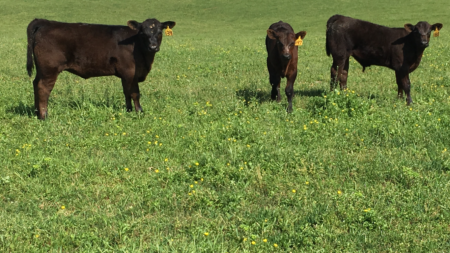

Dr. Troy Rowan
Assistant Professor
UTIA Genomics Center for the Advancement of Agriculture
P: 865-974-3190
Originally Published: Cattlemen’s News Magazine
When we think about what makes a commercial cowherd exceptional, we must remember the long-term role that effective sire selection plays. Nailing the bull-buying decision is essential for the long-term success of an operation. This decision impacts not only the calf crops that a bull sires during its lifetime but also performance in successive generations when replacement females are retained. Long-lived females are the cornerstone of a profitable commercial operation, so identifying bulls that will sire productive daughters is essential.
A commercial cow typically doesn’t become profitable until six years of age. Only then has it recouped the cost of its development and maintenance costs. We know that heifer development done the right way is not cheap, so cows leaving the heard before that profitable age are likely losing money. Since cow longevity is such an important trait, and bulls are the chief driver of genetic progress in a commercial herd, having EPD-based selection tools for cow productivity is essential for long-term genetic improvement. Predicting a bull’s genetic ability to make long-lived daughters allows us to better evaluate its “big picture” contributions to the herd.
Many breed associations report cow longevity EPDs. The most common measure is stayability (STAY). STAY EPDs can be interpreted as the difference between sires in the percentage of daughters that will remain in the herd until age six without missing a calf. For example, if Bull A’s STAY EPD was 20 and Bull B’s was 30, we’d expect that 10% more of Bull B’s daughters would remain in the herd at age 6. The results of using STAY in practice are striking. An analysis from the American Simmental Association showed that daughters of bulls in the top 25% of the breed for STAY were twice as likely to remain in the herd at age six compared with daughters of bulls in the bottom 25% of the breed. Daughters of high STAY (top 25%) sires had an average of two more calves in their productive lifetime than daughters of low STAY sires.
Stayability is a compound trait, meaning that it is made up of multiple other individual component traits. All of the reasons we could imagine culling a cow from the herd early play into STAY: Fertility, structural soundness, udder quality, disposition, maternal ability, and other traits. Many breed associations also directly report EPDs for individual cow-focused traits. This allows us to select for important female traits in breeds without STAY EPDs, as well as on specific components of overall longevity that a particular herd might need. For example, we might see that our herd is plagued by foot and leg issues, causing us to cull otherwise fertile and productive four and five-year-old females. The American Angus Association reports EPDs for Foot Angle and Claw Set (in both cases, smaller EPD = more favorable phenotypes) that could allow us to more accurately identify bulls that will pass down structural soundness to their offspring.
It was pointed out to me by a seedstock producer and friend here in Tennessee that the way we’ve historically talked about these cow-focused traits has missed the mark. For a long time, these were branded as “convenience traits” based on their potential to decrease the labor involved with a given cow. While more convenient cows are undoubtedly nice, it’s clear that fertile, thrifty, sound, docile, and productive cows are central to commercial cow-calf profitability. These female-focused traits have an inherent economic value and are foundational to the success of a commercial herd. As such, we’ve started calling these “foundation traits.”
Each of these traits plays into the overall profitability of a sire’s offspring when a producer retains replacement females. Balancing these traits while also trying to make genetic progress on other revenue-generating traits (i.e., weaning weight) can be a handful. Each trait contributes to overall profitability to varying degrees. Some of these traits are genetically correlated in favorable (e.g., stayability and structural soundness) and unfavorable (e.g., weaning weight and mature cow weight) ways. Breed associations have worked to develop economic selection indexes that weight multiple traits by their relative economic importance in a general production system. The result is a single value that can be interpreted as an “EPD for profit” that considers many economically relevant traits. Indexes can be maternal, terminal, or composite-focused. For producers that are marketing calves at weaning and retaining replacement females, maternal indexes are ideal because they place heavy emphasis on cow-focused foundational traits and on maintaining weaning performance. It is important to understand the component traits that make up an index before using it. While I won’t detail individual indexes, I will point out that breed association websites do a great job describing the production scenarios that their indexes are designed for and the traits contained in the index.
Using a maternally-focused index alongside foundational trait EPDs to select bulls can keep your operation focused on selecting for the most important trait: Profit! The genetic tools that I’ve discussed here take the guesswork out of selecting bulls that will produce the sort of daughters that will keep our herds profitable and successful for the long term.
